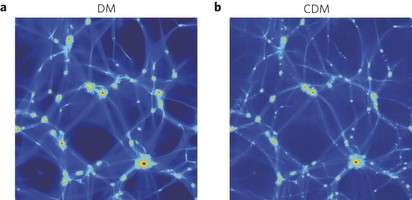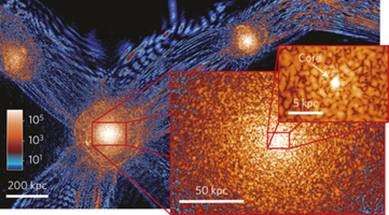Reinterpreting dark matter

Tom Broadhurst, an Ikerbasque researcher at the University of the Basque Country (UPV/EHU), has participated alongside scientists of the National Taiwan University in a piece of research that explores cold dark matter in depth and proposes new answers about the formation of galaxies and the structure of the Universe. These predictions, published in the prestigious journal Nature Physics, are being contrasted with fresh data provided by the Hubble space telescope.
In cosmology, cold dark matter is a form of matter the particles of which move slowly in comparison with light, and interact weakly with electromagnetic radiation. It is estimated that only a minute fraction of the matter in the Universe is baryonic matter, which forms stars, planets and living organisms. The rest, comprising over 80%, is dark matter and energy.
The theory of cold dark matter helps to explain how the universe evolved from its initial state to the current distribution of galaxies and clusters, the structure of the Universe on a large scale. In any case, the theory was unable to satisfactorily explain certain observations, but the new research by Broadhurst and his colleagues sheds new light in this respect.
As the Ikerbasque researcher explained, "guided by the initial simulations of the formation of galaxies in this context, we have reinterpreted cold dark matter as a Bose-Einstein condensate". So, "the ultra-light bosons forming the condensate share the same quantum wave function, so disturbance patterns are formed on astronomic scales in the form of large-scale waves".
This theory can be used to suggest that all the galaxies in this context should have at their centre large stationary waves of dark matter called solitons, which would explain the puzzling cores observed in common dwarf galaxies.

The research also makes it possible to predict that galaxies are formed relatively late in this context in comparison with the interpretation of standard particles of cold dark matter. The team is comparing these new predictions with observations by the Hubble space telescope.
The results are very promising as they open up the possibility that dark matter could be regarded as a very cold quantum fluid that governs the formation of the structure across the whole Universe.
This is not Thomas Broadhurst's first publication in the prestigious journal Nature. In 2012, he participated in a piece of research on a galaxy of the epoch of the reionization, a stage in the early universe not explored previously and which could be the oldest galaxy discovered. This research opened up fresh possibilities to conduct research into the first galaxies to emerge after the Big Bang.
More information: H-Y. Schive, T. Chiueh & T. Broadhurst. "Cosmic structure as the quantum interference of a coherent dark wave." Nature Physics, 2014. DOI: 10.1038/nphys2996
Journal information: Nature Physics , Nature
Provided by University of the Basque Country





















